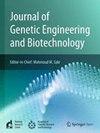端粒RNA四联体作为癌症预防的靶点:阿贡肽的治疗潜力
IF 2.8
Q3 Biochemistry, Genetics and Molecular Biology
Journal of Genetic Engineering and Biotechnology
Pub Date : 2024-12-31
DOI:10.1016/j.jgeb.2024.100454
引用次数: 0
摘要
癌症仍然是一个可怕的挑战,尽管多年来针对蛋白质控制其无情的生长和扩散。真菌代谢物是天然化学物质的宝藏,它给我们带来了一线希望。端粒,细胞的“帽”,是癌症研究的焦点。本研究探讨了稳定端粒内含有端粒重复序列的RNA g -四重体(TERRA G4)结构的潜力。这种稳定性可能会阻断端粒酶(修复端粒的酶),并可能引发癌细胞死亡。选择了两种有前景的真菌代谢物agonodepides A和B来研究这种令人兴奋的可能性。方法采用SwissAdme对agonodepide A和B进行初步药物相似性筛选。使用AutoDock Vina进行分子对接,使用PyRx和MGL工具制备配体和TERRA G4。利用Discovery Studio软件可视化配体与TERRA G4之间的相互作用。为验证对接结果,对250 ns的控制器和复合物进行了MD仿真,并对不同参数下的轨迹进行了分析。用MMPBSA计算对照物和配合物的结合自由能。通过主成分分析(PCA)和自由能图分析(FEL)寻找配合物的稳定和低能态,并与控制相比较。结果两种阿agonodepides的吸收、分布、代谢和排泄(ADME)均符合Lipinski法则,且无违逆。分子对接揭示了氢键、范德华作用、π-烷基和π-阴离子等关键相互作用。MD模拟表明,Agonodepside A与TERRA G4相互作用并稳定,而Agonodepside B的相互作用是短暂的。MMPBSA结合自由能计算、PCA和自由能景观支持对接和MD仿真结果。结论地衣化真菌产生阿戈肽苷A和B,可能通过端粒靶向抗癌。阿agonodepide A与端粒的结合比B更强,可能阻断端粒酶。需要进一步的研究来验证这些发现并评估潜在的安全问题。本文章由计算机程序翻译,如有差异,请以英文原文为准。
Telomeric RNA quadruplexes as targets for cancer prevention: The therapeutic potential of agonodepsides
Background
Cancer remains an awful challenge, despite years of targeting proteins to control its relentless growth and spread. Fungal metabolites, a treasure of natural chemicals, offer a glimmer of hope. Telomeres, the cellular “caps,” are a focal point in cancer research. This study explores the potential of stabilizing Telomeric Repeats-containing RNA G-quadruplex (TERRA G4) structures within telomeres. This stabilization could block telomerase, the enzyme that repairs telomeres, and potentially trigger cancer cell death. Agonodepsides A and B, two promising fungal metabolites, were chosen to investigate this exciting possibility.
Methods
Agonodepside A and B were initially screened for drug likeness employing SwissAdme. AutoDock Vina was used for molecular docking, and ligands and TERRA G4 were prepared using PyRx and MGL tool. Discovery Studio software was utilized for the visualization of interactions between ligands and TERRA G4. For validation of docking results MD simulation for control and complexes was carried out for 250 ns and trajectories were analyzed for different parameters. MMPBSA was used to calculate binding free energy for control and complexes. To find the stable and lower energy states of complexes in comparison to control principal component analysis (PCA) and free energy landscape (FEL) were conducted.
Results
Absorption, distribution, metabolism, and excretion (ADME) of both agonodepsides followed Lipinski’s rule of five with zero violation. Molecular docking revealed several key interactions including hydrogen bonds, van der Waals interactions, π-alkyl and π-anion. MD simulation revealed that Agonodepside A interact with TERRA G4 and stabilize it while Agonodepside B interactions were transient. The MMPBSA binding free energy calculation, PCA and free energy landscapes supported the docking and MD simulation results.
Conclusion
Lichenized fungi produce agonodepsides A and B, may fight cancer by targeting telomeres. Agonodepside A binds more strongly to telomeres than B, potentially blocking enzyme telomerase. Further studies are required to validate these findings and evaluate potential safety concerns.
求助全文
通过发布文献求助,成功后即可免费获取论文全文。
去求助
来源期刊

Journal of Genetic Engineering and Biotechnology
Biochemistry, Genetics and Molecular Biology-Biotechnology
CiteScore
5.70
自引率
5.70%
发文量
159
审稿时长
16 weeks
期刊介绍:
Journal of genetic engineering and biotechnology is devoted to rapid publication of full-length research papers that leads to significant contribution in advancing knowledge in genetic engineering and biotechnology and provide novel perspectives in this research area. JGEB includes all major themes related to genetic engineering and recombinant DNA. The area of interest of JGEB includes but not restricted to: •Plant genetics •Animal genetics •Bacterial enzymes •Agricultural Biotechnology, •Biochemistry, •Biophysics, •Bioinformatics, •Environmental Biotechnology, •Industrial Biotechnology, •Microbial biotechnology, •Medical Biotechnology, •Bioenergy, Biosafety, •Biosecurity, •Bioethics, •GMOS, •Genomic, •Proteomic JGEB accepts
 求助内容:
求助内容: 应助结果提醒方式:
应助结果提醒方式:


